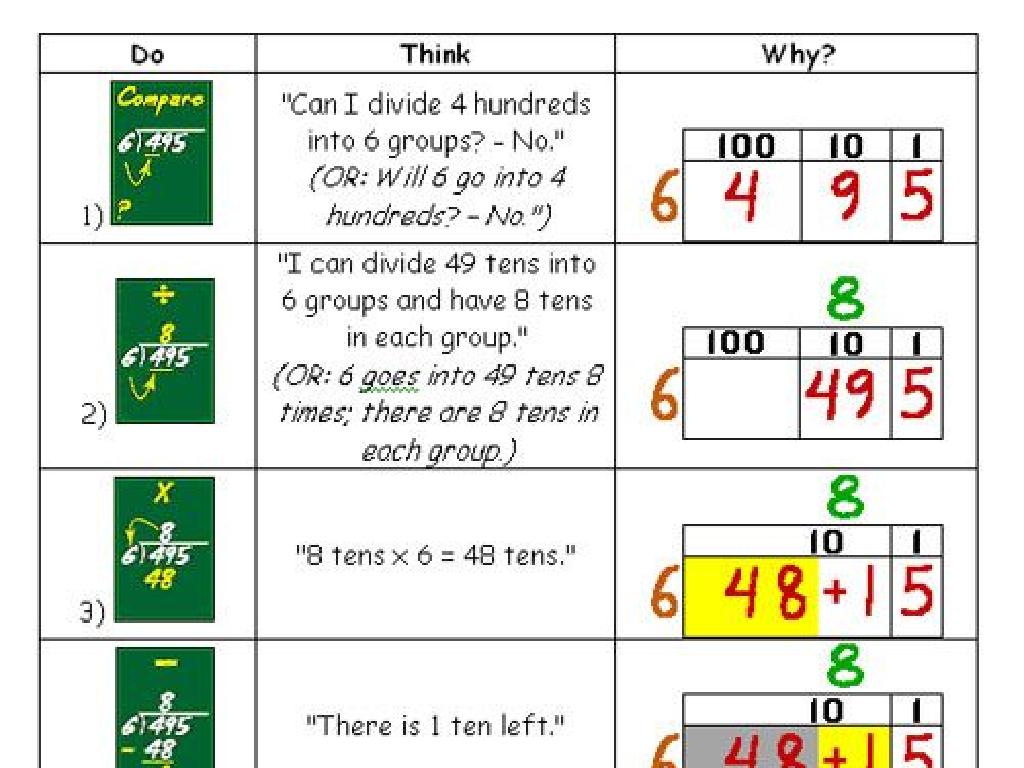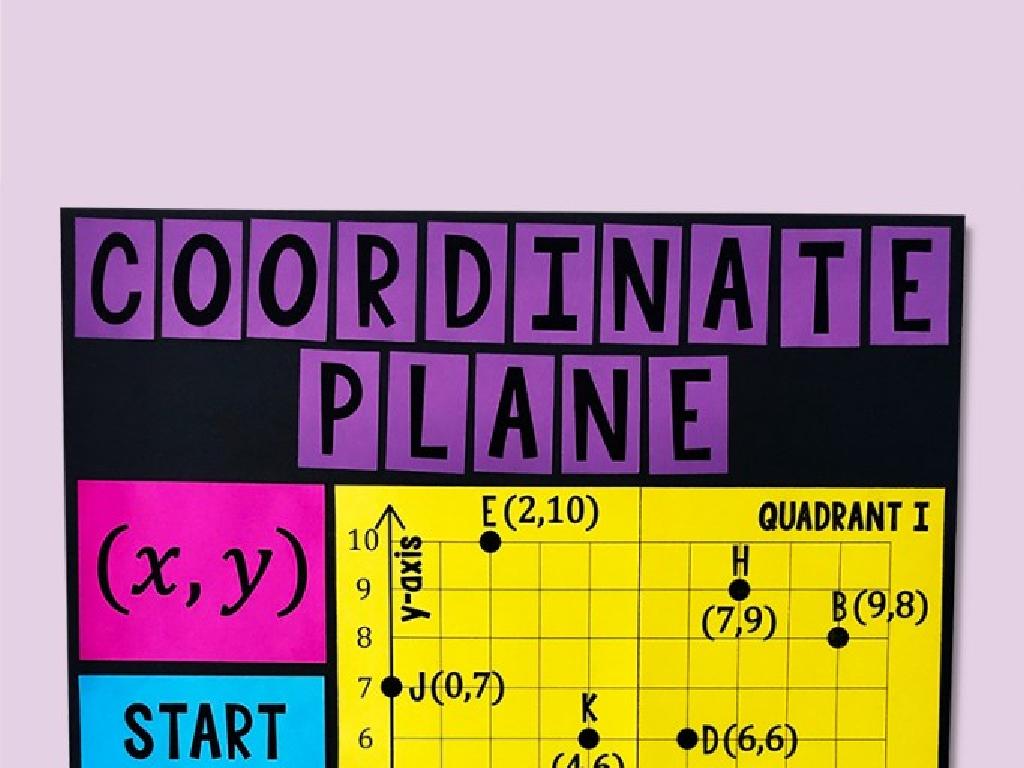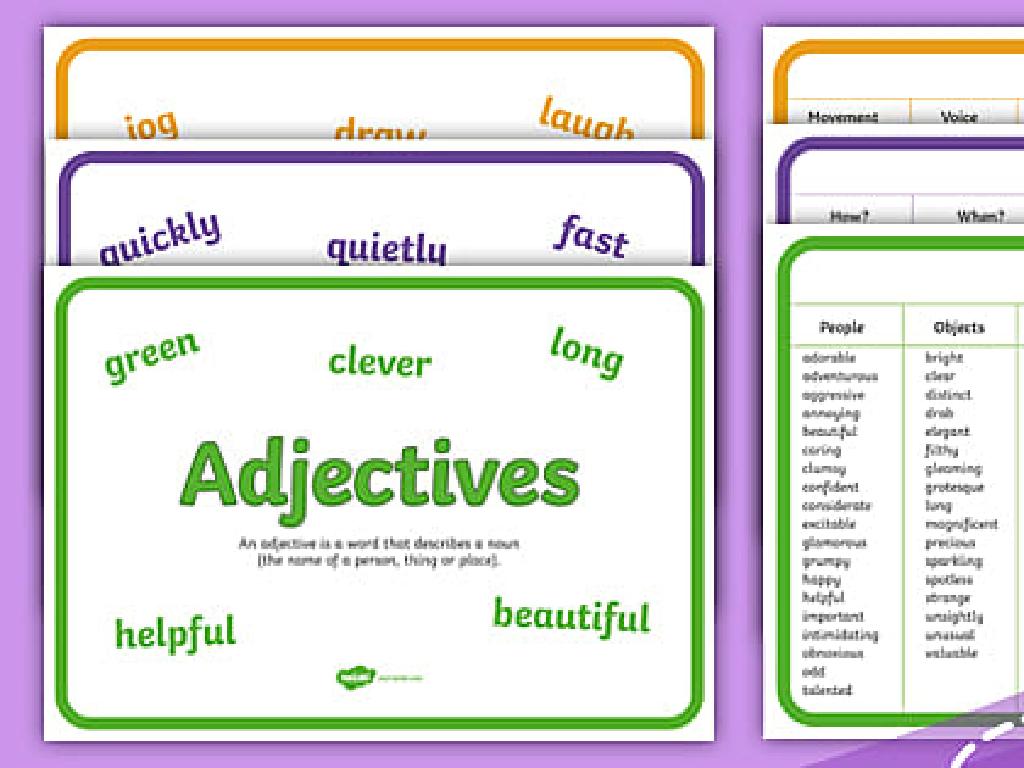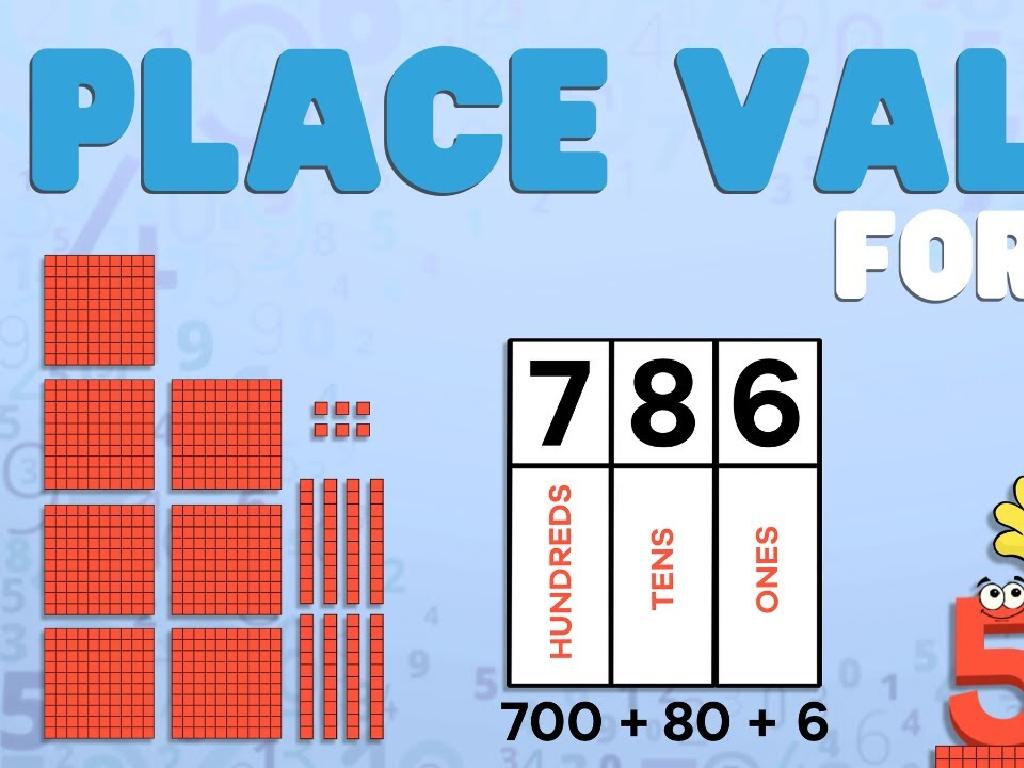Subtract Fractions With Unlike Denominators
Subject: Math
Grade: Fifth grade
Topic: Add And Subtract Fractions
Please LOG IN to download the presentation. Access is available to registered users only.
View More Content
Understanding Fractions: Basics and Beyond
– Recap: What are fractions?
– Fractions represent parts of a whole; top number is the numerator, bottom is the denominator.
– Like vs. Unlike Denominators
– Like denominators have the same bottom number; unlike denominators do not.
– Fractions in Daily Life
– Use fractions when cooking, budgeting, or measuring.
– Why learn about fractions?
|
Begin with a quick review of fractions, ensuring students recall that a fraction consists of a numerator (top part) and a denominator (bottom part), which together represent parts of a whole. Clarify the difference between like denominators (same bottom number) and unlike denominators (different bottom numbers), which is crucial for adding and subtracting fractions. Highlight the relevance of fractions in everyday scenarios such as cooking (e.g., half a cup of sugar), budgeting (e.g., spending 3/4 of allowance), or measuring lengths. Emphasize the importance of understanding fractions as a foundational skill in math, which will be used throughout their academic and daily lives. Encourage students to think of other areas where they encounter fractions.
Subtracting Fractions with Like Denominators
– Review: Subtracting same denominator fractions
– Remember, just subtract the numerators!
– Example: 3/4 – 1/4
– What do we get when we subtract 1/4 from 3/4?
– Class Practice: Solve subtraction problems
– Each student will try similar problems on their own
|
Begin with a quick review of how to subtract fractions that have the same denominator by simply subtracting the numerators and keeping the denominator the same. Provide an example problem on the board, such as 3/4 – 1/4, and solve it together with the class. For class practice, distribute worksheets with similar problems for students to solve independently. This will reinforce their understanding and prepare them for subtracting fractions with unlike denominators. As they work, walk around the classroom to offer help and ensure understanding. Collect the worksheets at the end to assess individual student comprehension.
Subtracting Fractions with Unlike Denominators
– Understanding unlike denominators
– Denominators are different, e.g., 1/3 vs. 1/4
– Why direct subtraction doesn’t work
– Fractions must be equivalent to subtract
– Real-life examples of the concept
– Recipes or dividing a pizza into slices
– Finding common denominators
|
This slide introduces the concept of unlike denominators, which are fractions that have different bottom numbers. It’s important for students to understand that we cannot directly subtract these fractions because they represent parts of wholes that are not the same size. To illustrate this, use real-life examples such as combining different measurements in cooking or sharing a pizza among friends. Emphasize the need to convert fractions to have the same denominator before subtracting, which will be covered in subsequent lessons. Encourage students to think of other situations where they might need to combine or subtract amounts with different units.
Making Denominators Alike
– Find the Least Common Denominator (LCD)
– LCD is the smallest number that each denominator can divide into.
– Convert fractions to the same denominator
– Change fractions so they have the LCD as their denominator.
– Example: Finding the LCD
– For 1/3 and 1/4, the LCD is 12. Multiply to make denominators 12.
|
This slide introduces the concept of finding the Least Common Denominator (LCD) which is crucial for adding or subtracting fractions with unlike denominators. The LCD is the smallest multiple that is common to all denominators involved in the problem. Once the LCD is found, students will learn to convert the original fractions so that they all have the same denominator, making it possible to combine them. The example provided should be worked through step by step, showing students how to multiply the numerator and denominator of each fraction by the necessary number to achieve the LCD. Emphasize the importance of not changing the value of the fractions, just their form. Practice problems should be provided for students to apply these steps independently.
Subtracting Fractions with Unlike Denominators
– Steps to subtract fractions
– Find a common denominator, rewrite fractions, subtract numerators, simplify if needed.
– Class example: 3/4 – 1/6
– First, find a common denominator for 3/4 and 1/6, which is 12. Rewrite as 9/12 – 2/12, then subtract.
– Discuss the importance of each step
– Understanding each step ensures accuracy and builds a strong foundation for more complex problems.
– Practice with different examples
– Try subtracting 5/8 – 1/3 or 2/5 – 1/4 to reinforce the concept.
|
This slide introduces the process of subtracting fractions with different denominators. Start by explaining the steps: finding a common denominator, rewriting the fractions, subtracting the numerators, and simplifying the result if possible. Work through the example of 3/4 – 1/6 with the class, showing each step in detail. Discuss why each step is crucial, such as finding a common denominator to make the fractions comparable. Encourage students to understand the process rather than just memorizing steps. Finish with additional practice examples to solidify their understanding.
Fraction Subtraction Practice
– Work on practice problems
– Discuss solutions with peers
– Share your methods and learn from others
– Teacher provides support
– Get help on tricky problems
– Learn and have fun!
|
This slide is designed for a classroom activity where students will engage in practicing how to subtract fractions with unlike denominators. Provide a worksheet with a variety of problems. Encourage students to work independently at first and then discuss their solutions in small groups, fostering peer learning. The teacher should move around the classroom to observe student interactions, offer guidance, and support students who may be struggling. Emphasize the importance of understanding the process over just getting the right answer. Possible activities could include: solving problems on the board, creating their own subtraction problems, or peer-teaching a problem they’ve solved. The goal is to create a collaborative and supportive environment where students feel comfortable to explore and learn.
Review: Subtracting Fractions with Unlike Denominators
– Review today’s subtraction steps
– Recall finding a common denominator, then subtracting numerators.
– Address common misconceptions
– It’s not about subtracting denominators; focus on numerators after finding a common base.
– Answer your lingering questions
– What parts of today’s lesson are still confusing? Let’s solve them together.
– Practice makes perfect!
|
This slide aims to consolidate the learning from today’s lesson on subtracting fractions with unlike denominators. Begin by revisiting the step-by-step process, emphasizing the importance of finding a common denominator before subtracting the numerators. Address any common errors, such as subtracting denominators or not simplifying the final fraction. Open the floor to students for any questions they may still have, ensuring they leave the class with a clear understanding. End with encouragement to practice, as mastery comes with repetition. Provide additional examples or problems for students to work on as homework.
Class Activity: Fraction Subtraction Game
– Divide into small groups
– Receive fraction cards with unlike denominators
– Race to subtract fractions & find LCD
– LCD stands for Least Common Denominator
– Discuss group strategies post-activity
– Share and learn different approaches
|
This interactive game is designed to help students practice subtracting fractions with unlike denominators. Start by dividing the class into small groups, ensuring a mix of abilities in each. Provide each group with a set of fraction cards. The goal is for groups to race against each other to correctly subtract the fractions by finding the least common denominator (LCD) for each set. After the activity, lead a discussion where each group shares the strategies they used. This will help students learn from each other and understand different methods to find the LCD. Possible variations of the activity could include using timers for added excitement, offering hints for struggling groups, or having a ‘challenge’ round with more complex fractions.
Homework and Previewing Next Lesson
– Practice with homework problems
– Next lesson: Adding unlike denominators
– We’ll learn to add fractions with different bottoms
– Find real-life fraction examples
– Look for fractions in cooking or shopping
– Review today’s lesson for mastery
|
For homework, students should complete the assigned problems to reinforce their understanding of subtracting fractions with unlike denominators. The next lesson will build on this foundation by teaching them to add fractions with unlike denominators. Encourage students to find examples of fractions in their daily lives, such as in recipes or while shopping, to understand the practical applications of what they’ve learned. Remind them to review today’s lesson to ensure a solid grasp of the concepts before moving on. Provide a variety of problems in the homework to cater to different skill levels and include word problems to practice applying the concept in real-life scenarios.






